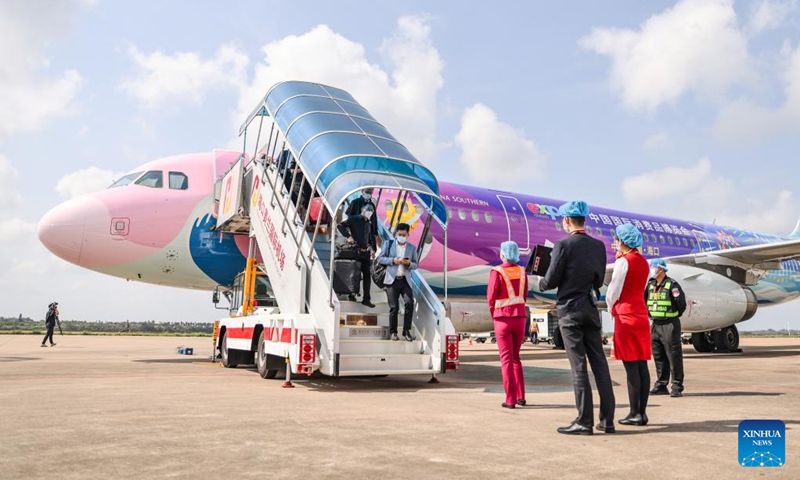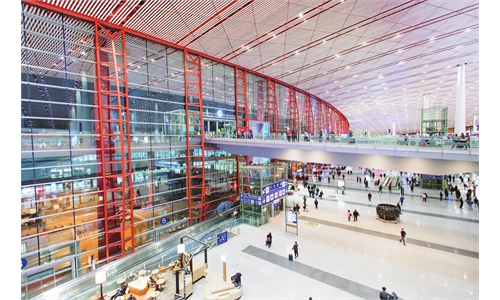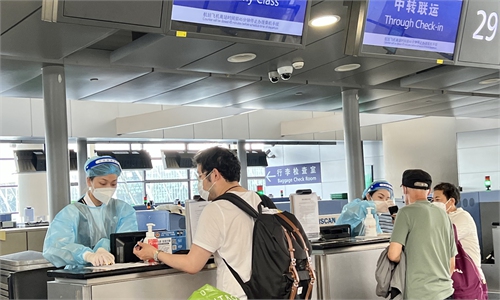Chinese airlines tap language training, internet livestreaming to generate more revenues

Passengers get off a plane painted with patterns of the China International Consumer Products Expo at Meilan International Airport in Haikou, south China's Hainan Province, March 13, 2022. (Xinhua/Zhang Liyun)
China Southern Airlines said recently that it will tap into the language training business, part of the airline's move to expand its business scope, which also reached into internet retail business and online travel services.
China Southern said its training center plans to launch both online and offline Japanese and French language training courses from July this year, in addition to launching an aviation summer camp for school children.
Face-to-face classes for basic French pronunciation is priced at 800 yuan ($119) for 20 teaching hours for small classes with 25 students, according to China Southern Training's WeChat account on June 14.
Hit hard by the coronavirus pandemic, the finances of many airlines are in dire straits, inflamed by weak market demand and reduced flight numbers, leading airlines to seek out innovative ways to generate more income to survive.
Since the early days of the pandemic in 2020, the chairman of Spring Airlines has promoted their air tickets and fuselage advertisements through livestreaming, China Eastern launched ticket packages, Sichuan Airlines has sold takeaway hot pot, and China Express Airlines started selling fruit and agricultural products via its WeChat account.
Meanwhile, China Southern set up a cross border e-commerce company in December of 2020, and Xiamen Airlines launched a group meal delivery services.
Airlines have been working hard to broaden their sources of revenues, but compared with the billions of yuan in losses linked to sharply reduced fights, income from live broadcasts, takeaways, and training courses is very limited.
Data from Civil Aviation Administration of China (CAAC) revealed the country's aviation industry lost 84.25 billion yuan last year, a decrease of 18.71 billion yuan over the previous year.
In the first quarter of 2022, China Southern recorded a net loss of 4.496 billion yuan, fellow airline China Eastern Airlines lost 7.76 billion yuan during the same period.
The industry has been on the receiving end of concessional policies, the CAAC said recently that it is negotiating with some countries to gradually and steadily increase regular international passenger flights to meet the needs of personnel exchanges, which industry watchers claimed would be critical in accelerating the recovery of the Chinese aviation market.
The CAAC has been negotiating with the aviation department of Vietnam and gave approval for flights twice a week, up from a previous one flight per week between the two countries, according to industry outlet carnoc.com.
Other countries such as Thailand and Italy are also on the negotiation list.
China Southern Airlines said recently that it plans to resume seven international routes from June, and that the number of international flights will increase from 36 flights per week to 48 flights, with the number of countries covered growing from 20 to 27.
Meanwhile, domestic flights are experiencing a degree of relief. In May, air passenger traffic was 12.073 million persons, down 76.4 percent year-on-year, but up 53.2 percent month-on-month, equivalent to 22.1 percent in the same period in 2019, CAAC data showed.
China's domestic travel demand is expected to peak over the summer time, with trips anticipated to recover to more than 70 percent of the same period in 2019, as the pandemic prevention and control has improved, a report by travel agency Ctrip.com said on Monday.



